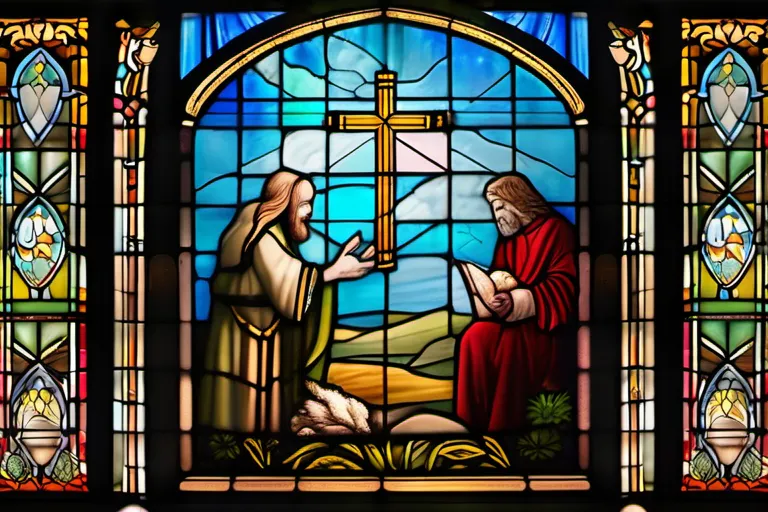Exploring the Historical and Theological Significance of the Old Testament in Christianity
The Bible, a sacred text for Christians, is divided into two main sections: the Old Testament and the New Testament. This article delves into the reasons why the Old Testament is included in the Christian Bible.
The Historical Context of the Old Testament
Imagine a vast library, where every book tells a story that intertwines with the next. The Old Testament, for Christians, is like the first few volumes that set the stage for the epic narrative found in the New Testament. But how did this collection of ancient texts find its way into the Bible we know today? Let’s delve into the historical origins and the journey of these sacred writings.
Why do Christians include the Old Testament in their Bibles?
- It’s not just about inclusion; it’s about understanding. The Old Testament is like a map, guiding us to understand the terrain before we embark on our spiritual journey.
- The stories and prophecies within these ancient texts are more than mere historical records—they are gateways to the divine plan of salvation. They offer a glimpse into a future that was hinted at long ago but only revealed in its entirety through Jesus Christ.
Historically, the Old Testament was compiled over centuries by various prophets and scribes. Each piece, whether it’s the law given through Moses or the wisdom teachings of Solomon, played a crucial role in shaping the religious and cultural landscape of Israel. Think of these writings as pieces of a puzzle that slowly began to fit together, each part contributing to the larger picture.
As these texts were passed down through generations, they journeyed with the people of Israel, surviving invasions, captivities, and eventual return to their homeland. The process of compilation was not just about gathering stories; it was a spiritual endeavor that sought to preserve the faith amidst adversity. Imagine how each scroll or parchment was like a lifeline, keeping the faith alive through dark times.
So, why did these ancient texts become part of the Christian Bible? It’s because Christians see them as essential. They are not just historical documents; they are living, breathing parts of God’s ongoing story with humanity. The Old Testament is like a river flowing into a larger ocean—essential to understanding where we came from and who we are in Christ.
By including the Old Testament, Christians affirm that the narrative of salvation began long before it was fully realized in Jesus Christ. It’s not just a choice; it’s an acknowledgment of the divine thread that runs through every page, weaving together the past with the present and the future.
The Theological Significance of the Old Testament
Why do Christians Include the Old Testament in their Bible? It’s like asking why we keep a map when traveling to a new place. The Old Testament, often seen as the foundation stone, provides us with a roadmap through history, prophecy, and wisdom that guides our spiritual journey.
Imagine the Old Testament as the bedrock of a house. Just as a sturdy base supports the structure above, the historical and theological significance of the Old Testament underpins Christian beliefs and practices. It is not just a collection of ancient texts but a vibrant tapestry woven with threads of prophecy, law, and wisdom.
One could argue that including the Old Testament in the Bible is akin to planting a seed. This seed, containing promises and prophecies, grows into a tree of life that offers sustenance and insight. For Christians, these scriptures are not just historical documents but living testimonies that speak directly to our faith.
Consider the stories of Abraham, Moses, and David—they are more than mere tales. They are archetypes of human struggle and divine grace, serving as examples for us to follow. The Old Testament is a mirror reflecting both the triumphs and failures of past generations, offering lessons on resilience and obedience that resonate with modern contexts.
Moreover, the inclusion of the Old Testament in the Christian Bible ensures a seamless transition from the covenants of old to the new covenant of Christ. It’s like connecting two pieces of a puzzle, revealing a comprehensive picture of God’s plan for humanity. This continuity not only enriches our understanding but also strengthens our faith.
In essence, the Old Testament is integral to Christian theology because it provides context, meaning, and direction. It is a bridge that connects the past with the present, offering us a profound sense of heritage and hope. As we delve into its pages, we uncover layers of truth and revelation that continue to inspire and guide believers today.
Continuity Between the Old and New Testaments
Imagine the Bible as a grand, sprawling city, where the New Testament is like its modern skyline, but without the Old Testament, it would be incomplete and bare. The Old Testament serves as the foundation upon which this magnificent structure stands, providing depth and continuity that enriches every aspect of Christian belief.
Think about key figures like Moses or David. They are not just names in ancient history; they are living, breathing examples of faith and obedience that echo through time into the New Testament. Take a moment to ponder: How would Jesus’ life be understood without the backdrop of these faithful ancestors? The Old Testament is the soil from which many Christian virtues and beliefs take root.
The themes of redemption, sacrifice, and covenant are like threads woven throughout both Testaments, connecting them in an unbreakable tapestry. For instance, the prophecy of a suffering servant in Isaiah (Isaiah 53) finds its fulfillment in Jesus Christ, fulfilling the promise through His crucifixion and resurrection. This prophecy is not just a historical fact; it’s a living link that binds together the old and new eras of God’s interaction with humanity.
Moreover, think about how the concept of covenant plays out. In the Old Testament, we see God making promises to His people, establishing a relationship based on trust and mutual agreement. The New Testament shows us that this covenant is not just maintained but expanded through Christ, offering salvation and grace to all who believe.
The Old Testament’s inclusion in the Bible isn’t merely a historical necessity; it’s a testament to the ongoing, dynamic nature of Christian faith. Without it, we would be like travelers trying to navigate unfamiliar territory without a map—lost and confused about our journey. The Old Testament guides us, teaching us about God’s character, His plans for humanity, and the profound truths that underpin Christian doctrine.
The Role of the Old Testament in Jewish and Christian Traditions
Why do Christians include the Old Testament in their Bible? It’s like asking why a family keeps a valuable heirloom—because it represents not just the past, but the very fabric of their identity and history.
Imagine the Old Testament as a treasure map, leading us to the Promised Land of understanding. For Jews, this map is a vital part of their spiritual journey, filled with stories that guide them in faith and practice. But for Christians, it’s more like having two sides of the same coin. The Old Testament isn’t just a historical record; it’s a living document, intertwined with Christian beliefs and traditions.
In both Judaism and Christianity, the Old Testament is seen as a revelation from God, filled with prophetic insights that foreshadow the coming of Christ. But here’s where things get interesting: while Jews see it primarily as a guide for their own lives, Christians read it through the lens of Jesus’ teachings. It’s like viewing an old painting in different lights—each time, you uncover new layers of meaning.
Consider how the stories of Abraham and Moses resonate differently with each faith. For Jews, these are foundational figures who established a covenant with God, setting the stage for their nation. But for Christians, they are preparatory steps, paving the way for Jesus to become the ultimate messiah. It’s as if both religions are part of a grand symphony, each playing different parts to create one harmonious piece.
The inclusion of the Old Testament in Christian Bibles is not just an act of reverence; it’s a declaration of continuity and unity. It’s like saying, ‘This is where we come from, and this is who we are.’ By preserving these ancient texts, Christians honor their roots while also pointing to the future, where old prophecies meet new realities.
So, why do Christians include the Old Testament? Because it’s more than just a collection of ancient stories—it’s a bridge between past and present, between earthly and divine. It guides us not only in understanding our history but also in navigating our faith journey today.
The Influence of the Old Testament on Christian Doctrine
Why do Christians include the Old Testament in their Bibles? It’s like asking why a tree needs its roots to stay strong and stand tall. The Old Testament, for Christians, is not just a book; it’s the foundation upon which the Christian faith is built.
Imagine the Bible as a vast castle with multiple towers, each representing a different section of Scripture. The Old Testament is like the ancient walls that hold everything together—without them, the entire structure would crumble. Morality, law, and worship in Christianity are deeply rooted in this historical and theological text.
Take morality for example. Many of the ethical principles we associate with Christian values—such as the Ten Commandments—find their origins in the Old Testament. These commandments serve not just as legal codes but as guiding lights that illuminate our path towards righteousness and justice. How else could a civilization navigate its moral compass without these foundational teachings?
Law, too, is intricately woven through the fabric of Christian doctrine. The covenant between God and Israel, detailed in passages like Exodus and Leviticus, lays down principles that resonate even today. It’s as if these ancient laws were seeds planted long ago; they’ve grown into towering trees that provide shade and sustenance for believers.
Then there is worship, the heartbeat of Christian life. The rituals and practices found in the Old Testament—like sacrifices and temple services—are precursors to the New Covenant represented by Jesus Christ. Just as a river finds its source high up on a mountain, Christian worship finds its roots deep within the pages of the Old Testament.
So why do Christians include the Old Testament? Because it’s not just a history lesson or an ancient text—it’s a living, breathing guide that helps us understand our relationship with God. It’s like having a map to navigate life’s storms; without it, we would be adrift in a sea of uncertainty.
The Old Testament is the wellspring from which Christianity draws its strength and wisdom. Its teachings shape not only what we believe but how we live our lives. It’s more than just a book; it’s the very heartbeat of Christian faith.
The Enduring Legacy of the Old Testament in Christianity
The Old Testament serves as a vast, intricate tapestry that weaves through the very fabric of Christian art and literature, much like how threads interlock to create a richly textured masterpiece. How did these ancient texts become so integral to the artistic and literary expressions of Christianity? One can only wonder if the stories, characters, and divine messages found in the Old Testament were simply too profound and timeless to be left out.
Consider the Bible, a collection of writings that Christians regard as divinely inspired. The inclusion of the Old Testament within it is not merely an act of historical preservation but a vital connection between the past and present, bridging the chasm of time with threads of wisdom and revelation. Through these ancient stories, Christian artists have found endless inspiration to create works that resonate deeply with faith and human experience.
From icons depicting the life of Moses or the prophets to stained glass windows in cathedrals illustrating key Old Testament narratives, each piece of art tells a story. These visual stories are not just static images but living narratives that engage the viewer’s imagination and spiritual senses, prompting them to reflect on the meaning behind the scenes portrayed.
Moreover, the Old Testament has been a rich source for Christian literature. Think of the poetic language in Psalms or the powerful imagery in the Book of Isaiah. These texts have inspired countless writers and poets who have sought to capture the essence of divine revelation in words that echo through generations. The metaphors and symbols found within these ancient writings often resonate with readers, providing them with a deeper understanding of God’s love and mercy.
The Old Testament’s role extends beyond mere literary inspiration; it also shapes Christian theology. For instance, the concept of atonement, which plays a central role in Christian beliefs about salvation, finds its roots deeply embedded within the sacrificial system described in Leviticus. These ancient texts provide a framework that helps Christians comprehend their relationship with God and the necessity of redemption.
In essence, the Old Testament is not just included in the Bible because it is old or historical; it is there to guide and inspire, offering timeless lessons that continue to shape Christian thought and practice. By including these ancient texts, Christianity has ensured a rich heritage that enriches both its past and its future.
Conclusion

By understanding the historical context, theological significance, and continuity between the Old and New Testaments, we gain a deeper appreciation for the Bible as a whole and its role in shaping Christianity.










